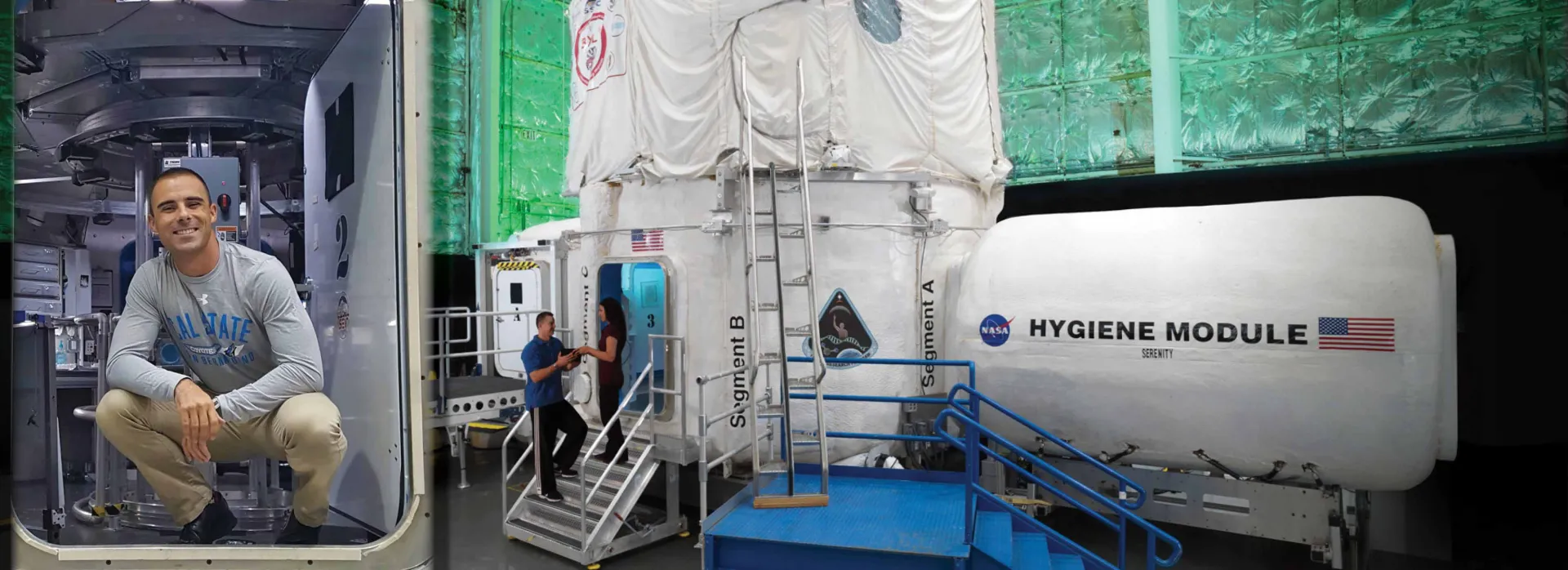
UPDATE, Aug. 30, 2017
HERA 14 mission cut short
Hurricane Harvey’s damaging reach included the simulated NASA space mission in which Richard Addante, a Cal State San Bernardino assistant professor of psychology, was a crew member.
The storm, which made landfall in southeast Texas on Aug. 25 and continued to pound the region in the days after, forced the shutdown of the second mission of the fourth campaign of the Human Exploration Research Analog, or HERA 14, on Aug. 27. The mission, which began on Aug. 5, was taking place at the Johnson Space Center in Houston.
Addante, in an email Aug. 29, said he and his fellow crew members were safe, but since Houston-area airports were shutdown due to the floods, he wasn’t sure when he would be able to return to California. He did add that he would be back in time for the start of the fall quarter on Sept. 21.
A NASA official said the conditions outside the Johnson Space Center were too dangerous for personnel to support the HERA mission operations — 42 inches of rain were recorded there from Aug. 25-28 — but the four-person crew was safe and in good spirits, and there was no damage to the building housing the simulation. The space center itself is closed through Sept. 5 to all but essential personnel, which includes those looking after the International Space Station operations.
HERA 14 was scheduled to last 45 days, ending on Sept. 18.
Tue, Aug. 8, 2017
CSUSB psychology professor on NASA mission to an ‘asteroid’
If anyone is trying to reach Richard Addante, you’ll have to excuse him — he’s sort of off the planet until Sept. 18.
Addante, an assistant professor of psychology at Cal State San Bernardino, is actually participating in a simulated NASA mission to Mars, which began on Aug. 5.
The mission, now being conducted at the agency’s Johnson Space Center in Houston, is the second of the fourth campaign of the Human Exploration Research Analog, or HERA.
Addante is a member of the HERA XIV crew of four who are participating in the space agency’s Human Research Program in a 45-day mission that simulates space exploration without leaving Earth. It is part of several research analogs, which NASA describes as “a situation on Earth that mimics physical and mental effects on the body experienced in space.”
While the HERA crew conducts its tasks inside the analog, the HERA analog team and researchers will monitor them from the outside, the space agency said. The “ground crew” and researchers will collect crew data on the physiological and psychological effects of extended isolation and confinement, team dynamics and conflict resolution.
According to NASA, the current crew, and the two to follow later this year and in 2018, will conduct the same experiments that will enable researchers to identify patterns and variances in data they gather. Experiments will include testing hardware prototypes, creating equipment with a 3-D printer, testing out a new concept for space food, flying a simulated exploration vehicle and a virtual extravehicular activity (EVA) on an asteroid, the space agency said.
The HERA program began in 2014 and is divided into four “campaigns” of four missions each. The first campaign in 2014 consisted of seven-day missions. The second campaign in 2015 extended the missions to 14 days, and the third campaign, which took place in 2016, lasted 30 days each. The first 45-day mission of the fourth campaign took place May 6-June 18.
Before Addante and his crewmates “departed” (the crew had what is called an “ingress” event to start the mission), he said in an email that “we have been doing a ton of really cool training on space walks, flight simulators, MRIs, EEG, NIRS, and much more.”
And to assure people trying to reach him that he wasn’t ignoring them, Addante said, “I will be unavailable for any communications with the outside world, except for with (the) mission control center, from Aug. 4 through Sept. 18th, so please do not be offended if I am unresponsive to email during this time.”
For more information, visit NASA’s Analog Mission web page.